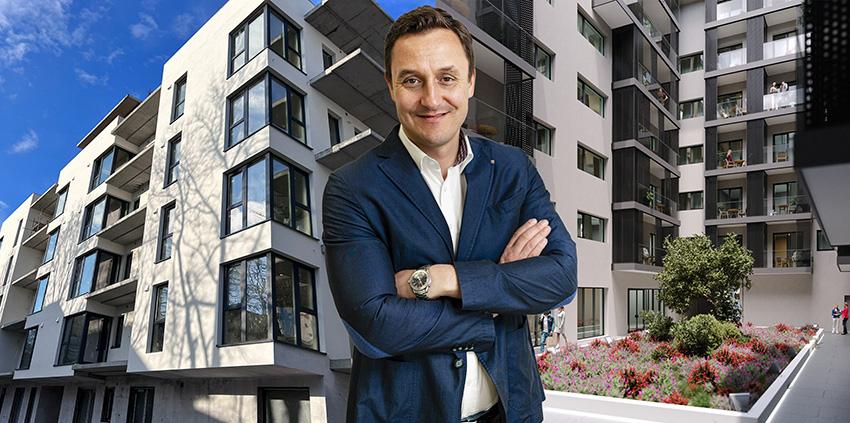2025-10-07
residential

Adi Steiner’s career began with Strabag, one of Europe’s largest construction companies, where he spent over a decade delivering major projects across Romania and Bulgaria. By 2009, he had risen to area manager for civil construction in Bucharest, overseeing landmark schemes such as Skytower, Promenada Mall, the Mark office building, and large-scale wind farms in Dobrogea. The role gave him broad technical expertise across multiple sectors, though always from the construction side, with a focus on tenders, delivery, and handovers. Financing and long-term development strategies were beyond his remit. By the mid-2010s, however, Steiner was ready for a new challenge. Advancement within Strabag in Romania was limited, and moving abroad was not the right choice for his family. Together with his wife Roxana, he decided to pivot toward real estate development. Spotting a gap in Bucharest’s residential market for higher-quality housing, they launched Quartier Gramont in 2019. It was a bold first step: the project was located in a protected area of the city centre, with heritage façades, but it set the tone for what would become STC Partners. Since then, the company has steadily grown, establishing a reputation for sustainable residential schemes designed with long-term value in mind. Against this backdrop, CIJ Europe sat down with Adi Steiner to discuss the economics of building nearly-zero and zero-emission projects, how buyers and banks are responding, and what lies ahead for STC Partners. One of the main challenges for STC Partners has been pushing beyond Romania’s minimum nZEB standard to deliver projects that approach or achieve zero emissions. At Quartier Azuga, the company introduced air-to-water heat pumps combined with photovoltaic panels, while retaining gas as a backup for hot water production during the winter months. The underfloor heating system, operating at 40–42 degrees, proved far more efficient with heat pumps than traditional systems. For the first 100 apartments, the additional cost of these upgrades amounted to about €85,000. At Quartier Ferdinand, however, the developer made the decision to go fully gas-free. The system uses roof-mounted air-to-water heat pumps to heat water for underfloor heating, while a booster pump raises part of that water to 65 degrees for domestic use. Photovoltaic panels feed electricity directly to the heat pumps and the building’s common spaces, supported by 8,000 litres of buffer tanks that store hot water during the day for evening and night consumption. This setup acts like a thermal battery, matching peak production with peak demand. Interestingly, Steiner notes that the costs balanced out: savings from eliminating the gas connection and plant offset the investment in additional technical equipment. Noise, often cited as a concern with roof-mounted heat pumps, has not proven problematic. Steiner points out that modern systems operate at around 35 decibels—equivalent to the minimum sound insulation required for residential windows. Located on the roof, the sound disperses upwards rather than horizontally, and during frequent site visits he has not encountered complaints. Compared with the noisier technology available two decades ago, today’s systems are much more advanced. Buyers, meanwhile, have responded positively. STC Partners does not charge a premium for the green upgrades, instead pricing projects at market level. Offering a zero-emission building in central Bucharest, where comparable product is scarce, provides a competitive edge. “Buyers like the idea of sustainability, but few are willing to pay extra for it,” Steiner explains. “The differentiation helps us sell faster, and that’s the real benefit.” Banks, too, are proving supportive. According to Steiner, institutions such as Banca Transilvania and BRD prefer to finance certified green projects. Independent labels like Green Homes, BREEAM, or EDGE add credibility that simple nZEB paperwork cannot, making financing more accessible and reinforcing trust with buyers. Ensuring buildings perform to their energy targets once completed is another key focus. STC Partners equips each project with a management system that optimises efficiency, programming heat pumps to operate during the day when solar panels are producing electricity. This renewable energy is stored in buffer tanks and used in the evenings. Residents are also trained during handover on waste sorting, heating and cooling management, and other sustainability practices. Each apartment includes a smart home system linked to the intercom, allowing residents to control heating and cooling remotely. Exterior roller shutters further help reduce solar gain, often removing the need for air conditioning even in extreme heat. The results are tangible. At one project, the photovoltaic system produced 6.3 MWh in March, with 4.56 MWh used directly on-site, 1.8 MWh fed into the grid, and 3.8 MWh purchased—mainly at night. By April, production rose to 8 MWh, and in June it delivered 7.45 MWh, with nearly two-thirds consumed within the building. Romania’s prosumer law allows overproduction in summer to balance higher consumption in winter, ensuring efficiency across the year. Looking ahead, STC Partners is preparing its next development, Quartier Pipera, with around 500 apartments across two phases near Pipera Plaza on the border of Voluntari and Bucharest. The ambition is once again to deliver a zero-emission project. “Buyers may not always ask for this,” Steiner says, “but banks and institutional investors increasingly require it. As long as costs remain under control, this is the model we will continue to pursue.” © 2025 www.cijeurope.com

